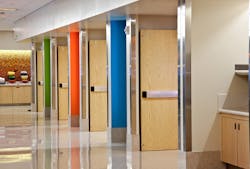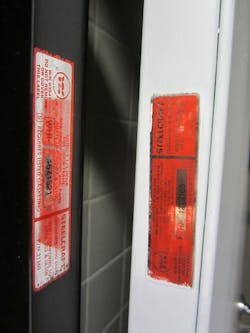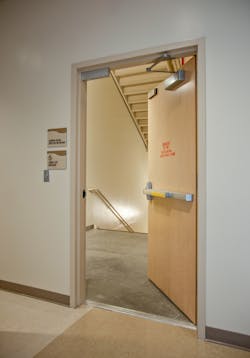Altering Fire-Door Assemblies
When they work on an existing fire door or labeled frame, many locksmiths are apprehensive about performing alterations that might void the rating of the assembly. This is a valid concern, but with an understanding of the limitations that apply to this work, fire-door assemblies may be modified safely in the field.
Two basic types of fire-door assembly alterations are addressed by NFPA 80:
- Job Site Preparations: These are changes made in the field that are allowed specifically by NFPA 80 – Standard for Fire Doors and Other Opening Protectives.
- Field Modifications: This work must be approved in advance by the listing laboratory (for example, UL or Intertek) and then can be performed without requiring the door or frame to be relabeled.
If a proposed change to a fire-door assembly isn’t allowed as a job-site preparation or a field modification, it might be able to be performed under label service, or the door or frame might be able to be relabeled in the field after the work is completed. This should be determined prior to the start of the work.
In the most recent edition of NFPA 80 (2022), alterations to existing fire-door assemblies are covered in Chapter 5 – Inspection, Testing, and Maintenance. The section that addresses job-site preparations and field modifications is Section 5.1.5 – Modifications.
Job-Site Preparations
NFPA 80-2022 addresses job-site preparations of fire doors in Section 5.1.5.2 – Job Site Preparation.This section permits limited alterations to be made on the job, including:
- Holes for surface-applied hardware – applied to the door or frame without removing material other than drilling round holes to accommodate cylinders, spindles and similar operational elements, electrified hardware and throughbolts
- Function holes for mortise locks
- Holes for labeled viewers
- Maximum three-quarters of an inch wood and composite door undercutting
- Installation of protection plates
Surface vertical-rod or rim panic hardware (fire exit hardware) would be considered surface-applied hardware, as would retrofit electrified lever trim for fire exit hardware — as long as the required job-site preparations involve only round holes. Most door closers, automatic operators, direct-hold electromagnetic locks, gasketing and coordinators also are surface-applied, and function holes for mortise locks and holes for labeled viewers are allowed specifically by this section of NFPA 80.
Previous editions of NFPA 80 limited the maximum diameter for round holes drilled in the field to 1 inch except for cylinders, which could be drilled in the size necessary to accommodate the cylinder. A new paragraph was added to the standard in the 2016 edition and was carried forward in the 2019 and 2022 editions. This change allows larger round holes for surface-mounted hardware to be drilled in the field, in accordance with the listings of the door and hardware manufacturers.
Before you drill larger holes, it’s important to verify whether the manufacturers’ listings allow these holes to be drilled in the field. When the hardware manufacturer’s installation instructions for a listed product show a field preparation for a hole, those installation instructions and templates are part of the listing file. This establishes that the hardware manufacturer’s listing allows the field prep. But the door or frame manufacturer’s listings also must allow the prep, and confirming this could take a little extra legwork.
Another change that was made in the 2016 edition of NFPA 80 is related to wire raceways, which accommodate wires that pass through the width of the door between electrified hardware and an electric power transfer or electric hinge. This preparation may be performed at the job site in accordance with the door manufacturer’s listings and when permitted by the listing laboratory. If a door manufacturer’s listings don’t include provisions for drilling raceways, the raceway is considered to be a field modification.
Field Modifications
When an alteration to a fire-door assembly is made in the field and it isn’t permitted by NFPA 80 as a job-site preparation, it’s considered to be a field modification. In the 2022 edition of NFPA 80, this work is addressed in Section 5.1.5.1 – Field Modifications.
If an alteration isn’t allowed prescriptively as a job-site preparation, permission may be requested in advance for a field modification. This typically is performed by contacting the manufacturer of the component being modified. The manufacturer then will contact the appropriate listing laboratory with a written or graphic description of the modification. Some examples of preps that wouldn’t be considered job-site preparations: a mortise lock pocket, a cylindrical lock prep, a concealed closer or concealed overhead stop, mortise for a butt hinge or a shear lock. These preps might be allowed as a field modification.
For example, most electric strikes require a rectangular cutout in the face of the frame, and job-site preparations are limited by NFPA 80 to round holes. Permission to make the rectangular modification in the field may be approved by the listing lab, after permission is requested through the frame manufacturer. Raceways also would require preapproval if the door manufacturer’s listings didn’t address raceways drilled in the field.
If the manufacturer of the component being modified no longer were available, the lab may be contacted directly, and an engineering evaluation that supports the field modification may be provided. A field visit from the listing laboratory isn’t required if permission for the field modification is granted by the lab. If modifications are made without prior approval, the doors or frames might have to be relabeled by the listing laboratory, which can be costly.
Filling Holes
Job-site preparations and field modifications sometimes result in holes left in the surface of a door or frame because of the removal of existing hardware. In the 2013 edition and prior, NFPA 80 required holes to be repaired by one of two methods:
- Installing steel fasteners that filled the holes completely.
- Filling the screw or bolt holes with the same material as the door or frame.
The 2016 edition of the standard clarified that the holes addressed by these methods were intended to be fastener holes.
A third method for filling fastener holes was added to the 2016 edition of NFPA 80: “Fill holes with material listed for this use and installed in accordance with the manufacturer’s procedures.”
This acknowledges the use of other materials that can be used to fill holes but only if the product is listed for filling holes in fire doors. If a product has been tested and listed for filling voids in walls or other surfaces, that doesn’t mean necessarily that it can be used to fill holes in fire-door assemblies.
At this time, few products have been listed for use in fire doors, and there are strict limitations on where they’re used. It’s important to verify the manufacturer’s listings regarding the size of the hole, the door or frame material, and the rating of the assembly. Filling holes that aren’t fastener holes typically is treated as a field modification, with permission required from the manufacturer or listing lab.
Conclusion
When you prepare to perform a field modification or when questions arise, it’s best to avoid problems by conducting research and planning in advance. Although NFPA 80 gives some direction with regard to protocols that must be followed when making alterations in the field, to get definitive answers, you might have to contact the manufacturer of the component being modified or even the listing laboratory on the label.
The door or frame label will contain helpful information to identify the manufacturer and test lab, along with a number that can be used to obtain more-detailed specifications. The manufacturer should be the starting point for most requests, followed by the listing laboratory.
When you modify a fire-door assembly in the field, keep in mind that each component attached to a swinging fire door must be labeled for this use. Typically, the product must be tested in accordance with UL 10C – Standard for Positive Pressure Fire Tests of Door Assemblies or NFPA 252 – Standard Methods of Fire Tests of Door Assemblies and use the positive pressure test method. Components that aren’t listed to these test standards may not be installed as part of a fire-door assembly.
Since the 2007 edition, NFPA 80 has required annual inspections of fire-door assemblies to ensure that they will perform as designed and tested if a fire were to occur. Beginning with the 2013 edition of the standard, fire-door inspections also are required after installation and maintenance work. The alterations mentioned in this article likely would result in the necessity for an inspection of the fire door, frame and hardware.
It’s important to note that the adopted code in a particular jurisdiction will reference a specific edition of NFPA 80, which might have different requirements than the most current version of the standard referenced in this article. In addition, local requirements could affect what’s allowed in a facility’s location. The authority having jurisdiction (AHJ) will have the final say.
Lori Greene, DAHC/CDC, CCPR, FDAI, FDHI, is manager, codes and resources at Allegion. Visit her website, idighardware.com.

Lori Greene, DAHC/CDC, CCPR, FDAI, FDHI
Lori Greene, DAHC/CDC, CCPR, FDAI, FDHI, is manager, codes and resources at Allegion. Visit her website, idighardware.com.






